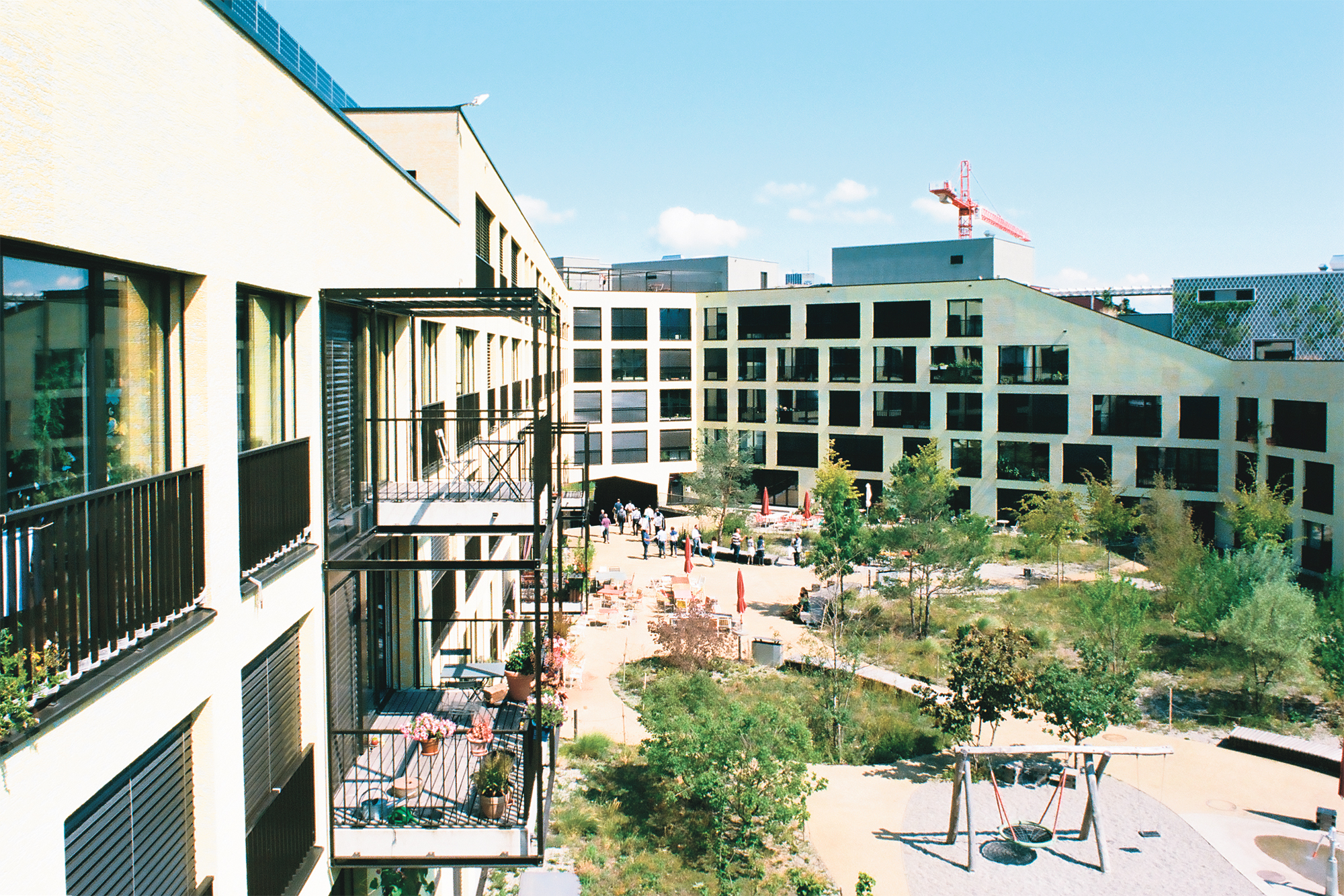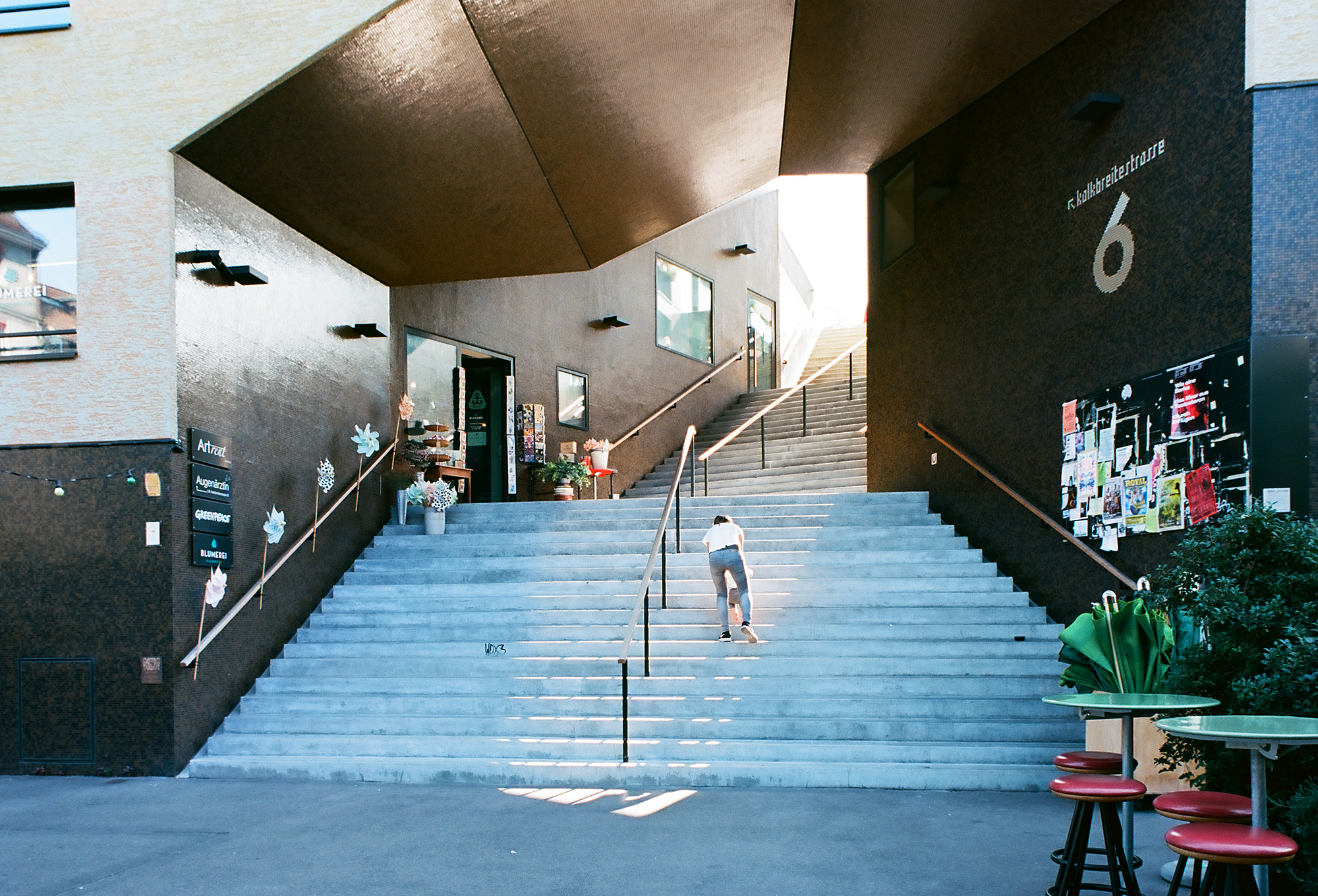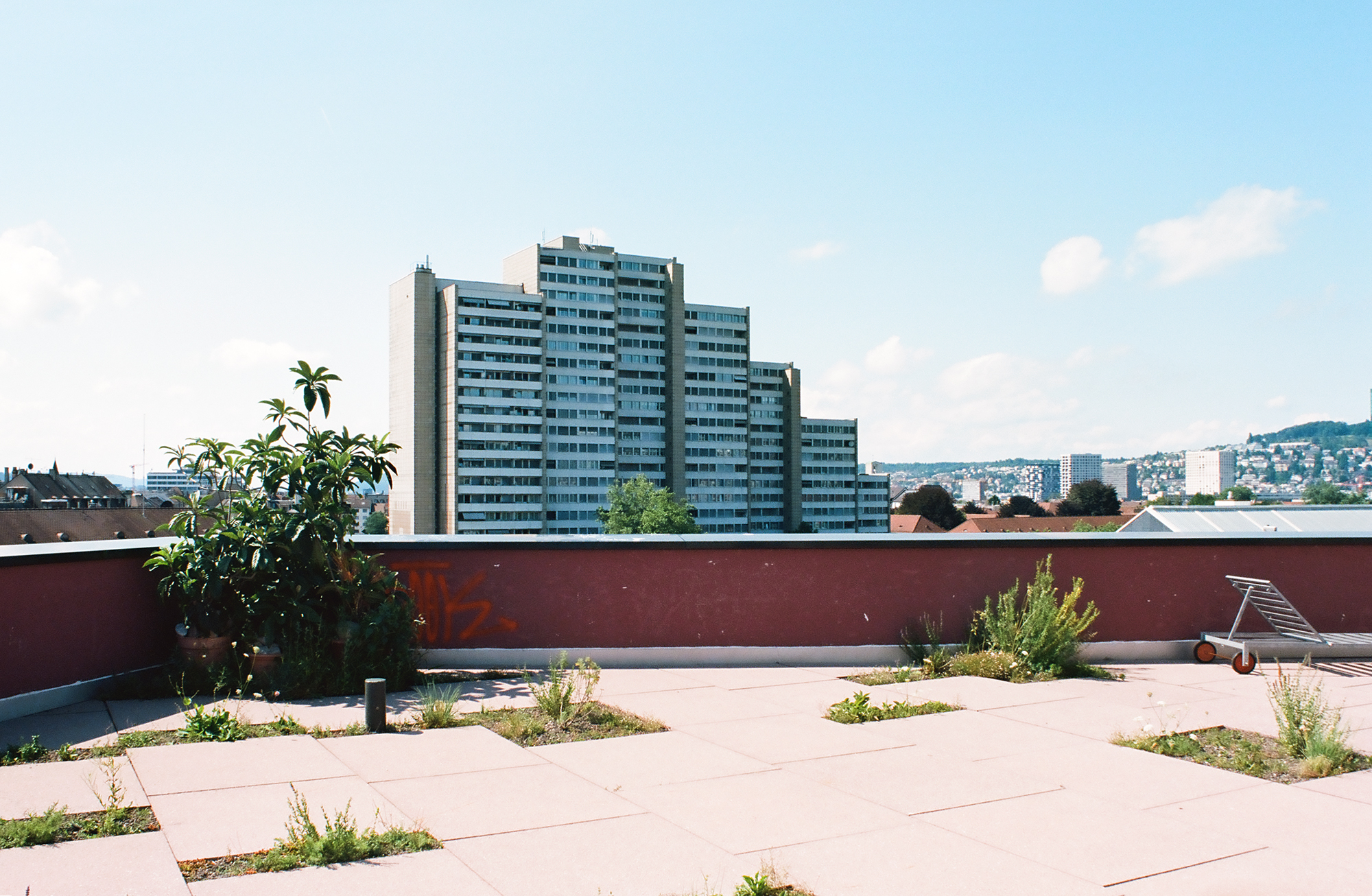Co-op City experiments with non-profit housing in Zürich
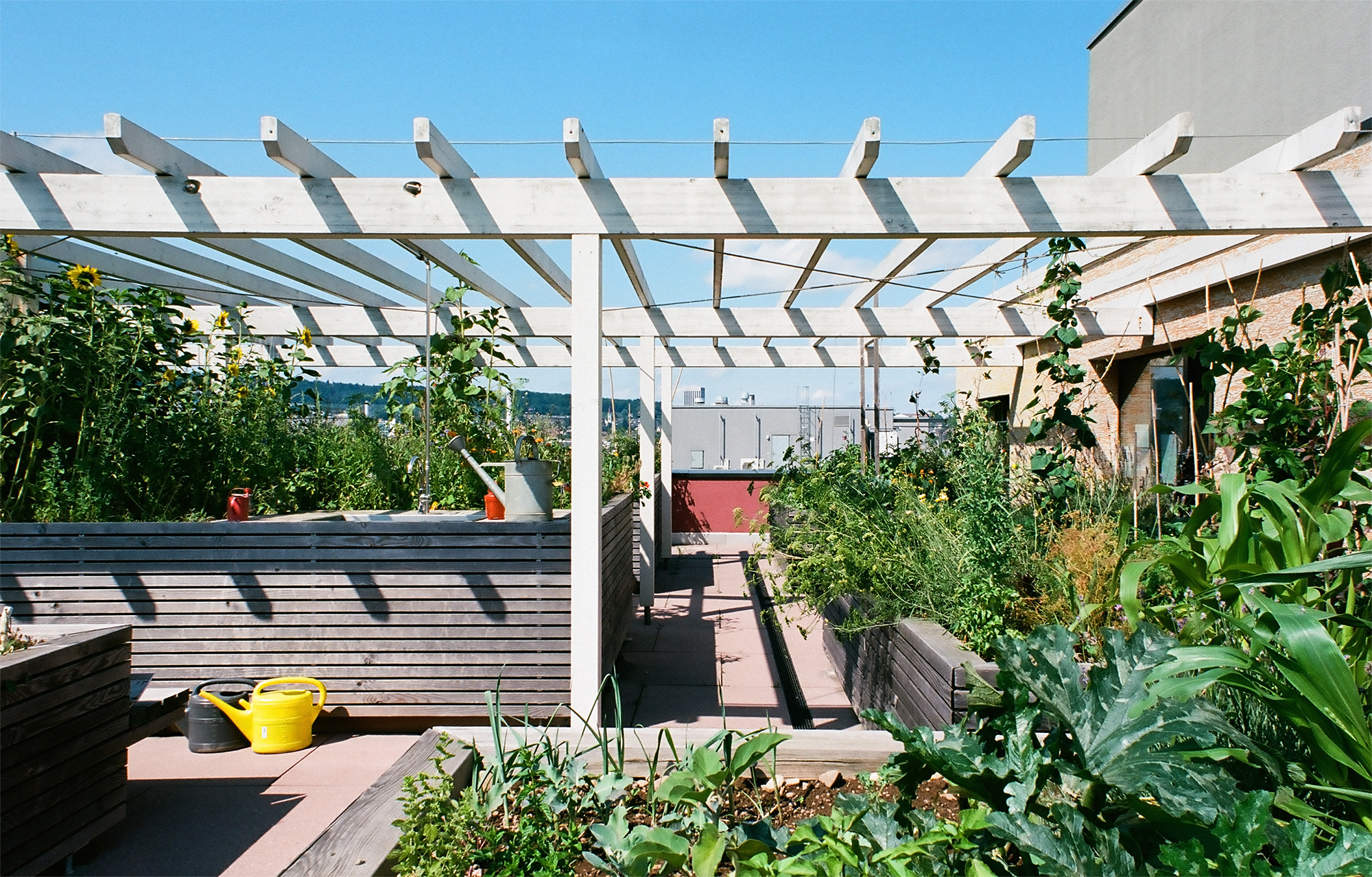
“You have to think big at the beginning—that’s the problem for most people.” I’m sitting with Thomas Sacchi on a warm Friday evening in the bar of the Houdini Cinema, Zürich. Propped next to a large window on the mezzanine level, we have an elevated vantage point as the Badenerstrasse strip stirs below. “When we first approached local authorities,” he continued, “our proposal was to build a new piece of city—to bring together work, living and culture.” Sacchi is on the board of the Kalkbreite Co-operative, where the Houdini is located, and was the project manager during the creation and construction of what has become Zürich’s emblematic co-operative housing development. He also rents an apartment in the mixed-use complex, completed just west of the city centre in August 2014.
Kalkbreite is unique in many ways. Owned by the City of Zürich and earmarked for potential development as far back as 1978, the awkward triangular plot, which is the size of a full city block, is flanked on one side by a sunken train line and remains a functioning tram depot. Thanks to a clever design scheme by Müller Sigrist Architekten that integrates the nine-metre high depot hall and curved track into the building’s supporting frame, the site now boasts 97 affordable housing units for approximately 250 people, 5,000 square metres of retail space, offices and ateliers, as well as a publicly accessible raised plaza. More striking than the architecture, though, is the economics. The project was initiated by a grassroots collective of ten people and developed in line with an independent non-profit model that rejects speculation in favour of sustainability.
Switzerland has a long history of co-operatives. As Andreas Hofer, one of the original leaders of the co-operative housing movement, later explained to me in his office at the seminal Kraftwerk1 development, “co-operatives are in some way part of the national myth.” The country’s two major supermarket chains, for example, were founded, and continue to operate, as co-operatives, with a combined membership exceeding half the Swiss population. An early 20th-century product of the broader European labour movement, co-operatives in Switzerland soon began to provide non-market rental housing to their working-class members. In the process, they acquired large land holdings at cut-price rates on what were then the peripheries of growing cities.

In 2007, Zürich celebrated the centenary of non-profit housing construction, with the inauguration of the Mehr als Wohnen (‘more than living’) project. But today’s co-operative renaissance has its roots in a more turbulent era. Despite its image as a rich and antiseptic city of bankers, Zürich in the 1980s and 1990s underwent a period of explosive change. The Züri brännt (‘Zürich is burning’) youth riots of 1980 birthed a rebellious countercultural movement, which eventually collided with a permissive drug scene that by 1986 had become a magnet for dealers and users across Europe. The decision, in 1992, to end an ill-fated experiment with an open-air drug market at the Platzspitz ‘Needle Park’, coincided with a citywide financial crisis triggered by the collapse of an overheated real estate bubble.
These social and economic upheavals were intertwined. As Zürich transformed in the 1980s from an industrial to financial centre, investors converted homes into offices, fuelling a housing shortage. The ensuing property frenzy led prices and rents to skyrocket. Apartments were often left empty, with their owners focused on profiting from a quick resale. Hofer arrived to study architecture during the ‘hot summer’ of 1982 and remembers that affordability was already a contentious issue: “It was impossible to live in the city.” A squatting scene that had emerged around cultural spaces quickly evolved into a broader movement. “It was not a radical left-wing thing. Because the problems were so pressing—even for the middle class—there was a spirit of solidarity. If one house was destroyed, we moved collectively to the next. Even in the richest areas, quiet occupations were tolerated.”
In part because of the drug epidemic—and the violence, crime and rampant prostitution that came with it—families were fleeing the city. But the high cost and limited availability of housing was even more alarming. By 1992, Zürich’s population had shrunk to its lowest level since 1945. Graduating in 1987, Hofer recalls that he and his friends felt personally confronted. “As professionals, we thought: what are we doing? Are we going to work with the speculators to destroy our city?” The group of young architects, geographers and planners formed the Konzeptgruppe Städtebau in 1988 to explore alternative urban development strategies. Three years later, they founded the International Network for Urban Research and Action (INURA), and visited cities like Berlin and Amsterdam that had begun to experiment with the legalisation of squats.
“We tried to decide whether the time was ripe not only to demonstrate, but also to promote a project,” Hofer says. The crisis of 1992 had coincided with heated debates around new planning laws, which in Zürich were updated on a 20-year cycle. Sensing an opportunity, Hofer, the artist Martin Blum, and anarchist author P.M. (Hans Widmer) printed 700 copies of a small book called Kraftwerk1—Projekt für das Sulzer Escher Wyss Areal, which contained a proposal for a self-organised, sustainable living-and-working complex to be built on a former industrial site. “We didn’t have money, we didn’t have land, we didn’t have anything,” Hofer explains. “But nobody wanted to invest in Zurich. So naturally, there was a big discussion about the future of the city. In a way, we were an answer.”
Encouraged by the reaction, the newly formed association organised the KraftWerkSommer festival in 1994. More than 60 events took place in a disused former factory, including concerts and parties, but also discussions and planning sessions focused on the project and a new vision for the city. Hofer laughs: “At the end we were completely bankrupt.” But the cultural program served its purpose—the Kraftwerk1 building and housing co-operative was formed the following year. “We contacted landowners and developers and because of the crisis it was not absurd for them to talk to us.” When a planned office development fell through, the new investor was open to ideas; “They were so desperate that they saw us as their last chance.”
Completed in 2001, the Kraftwerk1 development was not the first to experiment with collective approaches. But by taking advantage of existing co-operative frameworks and partnering with leading architects, it revived and opened up a stagnant sector, and became an important model for how to finance groundbreaking projects on former industrial sites. Sixteen years later, the basic approach is now well established. At Kalkbreite, members pay a refundable fee of 1,000 CHF ($1,300), providing the start-up capital. Residents then purchase an equity ‘share’ in the form of a 26,000 CHF ($34,000) deposit (also refundable). Rents are set per square metre by amortising the cost of the land lease plus construction loan over a 62-year period. If interest rates drop, so do rents, which are currently 20 percent below market levels. In theory, once the loan is paid off rents will only have to cover ongoing maintenance and operations.
The co-operative model has even greater appeal because, unlike Australia, Switzerland is a nation of renters. In Zürich, only nine percent of the population owns their home, in a city where the median house price exceeds 1.5 million CHF ($2 million). Long-term tenancy is an attractive prospect due to the security and stability offered by a system of open-ended leases, limited power to evict, and rent controls over the lifetime of a lease. But this also creates an uneven playing field, where remaining in the same apartment for a number of years equates to a greater and greater discount on the going market rate. The other factor is supply. The Zürich housing sector has been under strain since the late 1990s, when the city and economy began to rebound. Sustained high demand is reflected in incredibly low vacancy rates.
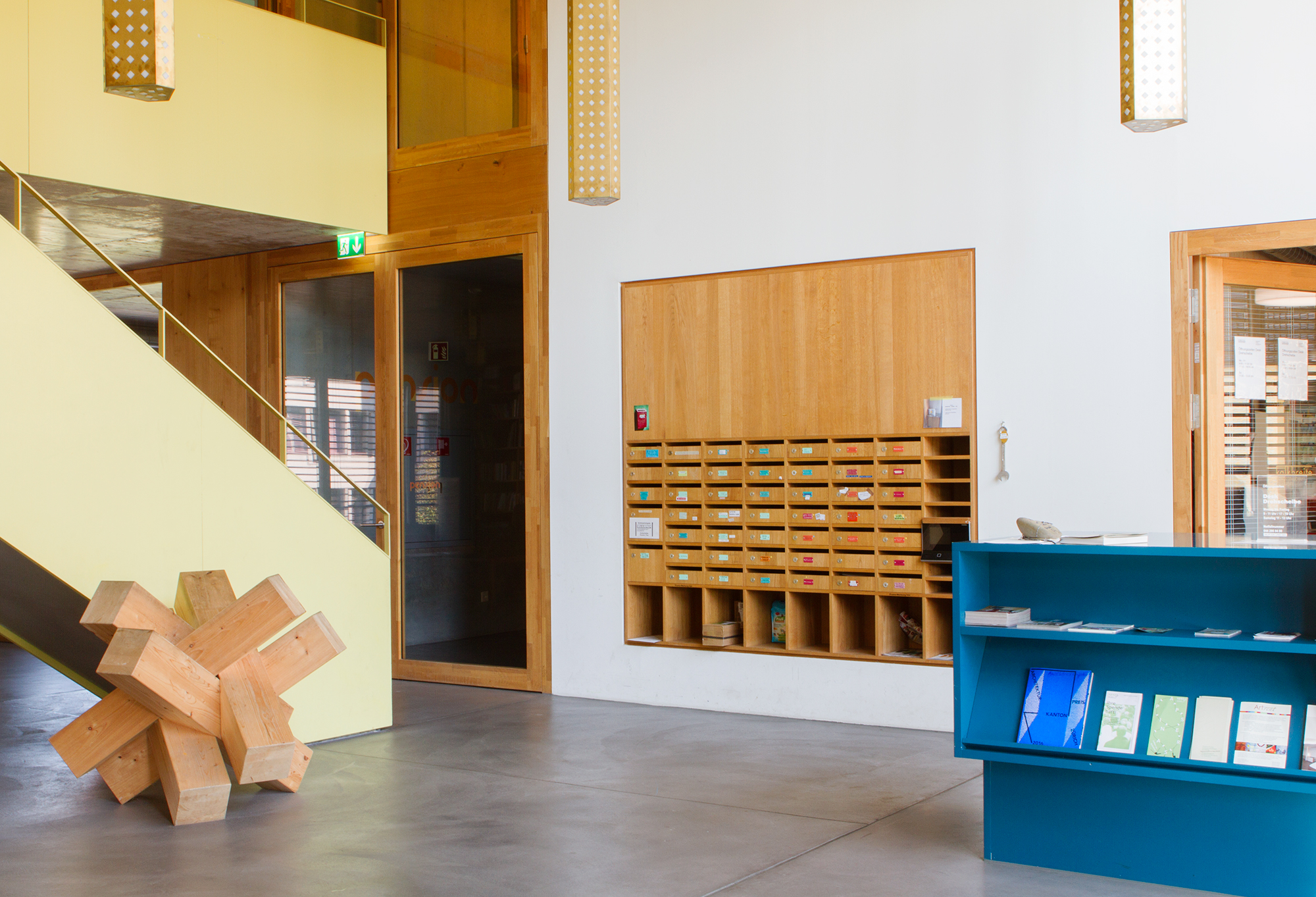

In a referendum held in November 2011, on the back of a decade of rising rents, three quarters of the population voted in favour of a ballot measure mandating that affordable, non-profit apartments make up one third of the city’s total rental stock by the year 2050. It was perhaps this event, more than any other, which has set the scene for an upswing in co-operative-driven construction in recent years. By Zürich standards, the target is not overly ambitious. Around 27 percent of rental apartments already operate on a non-profit basis, with 20 percent managed by co-operatives and the remainder by the municipality itself. The biggest challenge is the city’s continuing building boom. As the overall residential stock expands, non-profit construction is locked in a race to outpace private development.
Kalkbreite was one of a handful of projects featured in the exhibition Together! The New Architecture of the Collective, which opened in June at the Vitra Design Museum. It appeared alongside related developments in Germany, Japan, Austria, Denmark, the Netherlands, South Korea and the United States. When I asked Andreas Ruby, one of the exhibition’s curators, why he thought the projects were largely clustered in central Europe and east Asia, he was blunt: “Because the United States, United Kingdom and Australia are obsessed with home ownership. Europe is much more a renter’s market, so people are more open to non-ownership-based housing models. It is telling that the only project we have from the Anglo-Saxon world is for homeless people.”
When I put the question of exportability to Hofer, he was more optimistic. “Co-operatives can be a stabilising element in any real estate market. You can approach it as a pure financial system, where future profits are collectivised, and everyone gains from falling rents.” Then came the caveat. “But you cannot export it 1:1. People visit from all over the world and see a development that has worked, where rents are cheap and people are happy. But it has to be adapted to fit the local context.” And what about the turmoil that engulfed the city three decades ago? “The housing market is inherently conservative and influenced by strong political lobbies. So a financial crisis, a social crisis—these can trigger a crucial moment of reflection. It is possible to change the system through reason, but humans often need a deep crisis to get reasonable.”
This article originally appeared in Issue 8 of Assemble Papers, ‘Metropolis.’ A big thanks to Alexis Kalagas for introducing us to the co-operative housing initiative across Zürich. All photography in this piece is by Ciro Miguel. You can read more about the Kalkbreite co-operative on their website (German only), or join the urban revolution with INURA.
